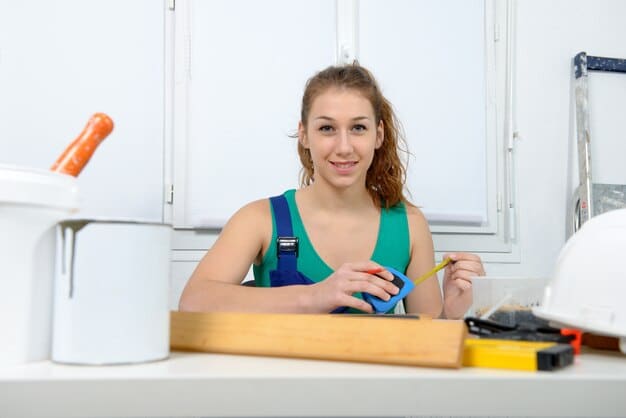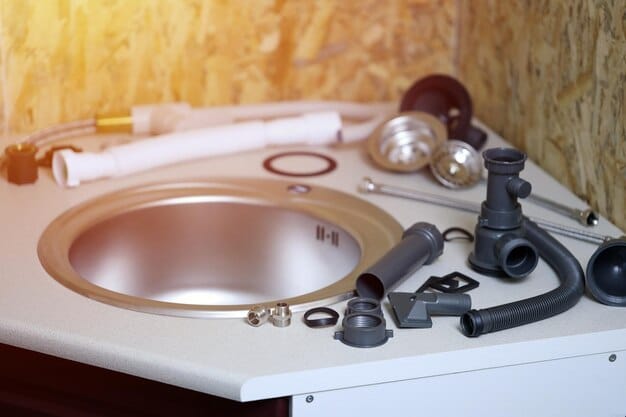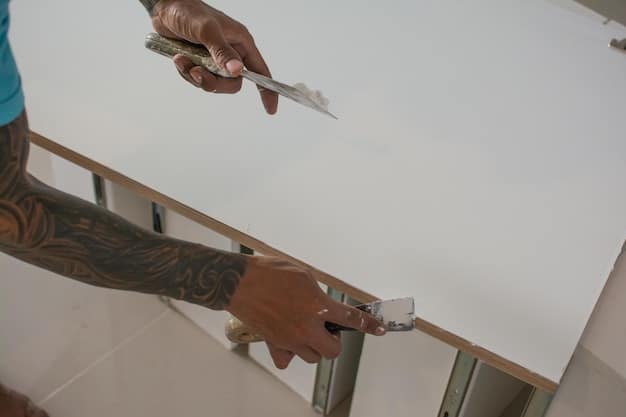DIY Home Repairs: Save Money and Fix It Yourself

Advertisements
DIY home repairs empower homeowners to tackle common household issues, saving hundreds of dollars on professional services while gaining valuable skills and increasing property value.
Embarking on DIY home repairs can seem daunting, but with the right knowledge and tools, you can fix common problems, save significant money, and gain a sense of accomplishment. Let’s explore how to become handy and take control of your home maintenance.
Advertisements
Essential Tools for DIY Home Repairs
Having the right tools is crucial for successful DIY home repairs. A well-equipped toolbox can make even challenging tasks manageable. Here’s a rundown of some essential tools every homeowner should have.
Basic Hand Tools
These are the workhorses of any DIY project. Invest in quality versions for durability and ease of use.
Advertisements
- Screwdrivers: A variety of Phillips head and flathead screwdrivers in different sizes.
- Pliers: Slip-joint pliers, needle-nose pliers, and lineman’s pliers are all useful for different tasks.
- Wrench Set: An adjustable wrench and a set of open-end wrenches will handle most plumbing and mechanical tasks.
- Hammer: A standard claw hammer is essential for driving nails and demolition.
Power Tools to Consider
While not always essential, power tools can significantly speed up and simplify many home repair tasks.
- Drill/Driver: A cordless drill/driver is invaluable for drilling holes and driving screws.
- Circular Saw: Useful for cutting lumber and plywood for various projects.
- Sander: An orbital sander can make quick work of sanding surfaces before painting or staining.
Having these essential tools on hand will prepare you for a wide range of DIY home repairs, saving you time and money in the long run. Remember to always prioritize safety by wearing appropriate personal protective equipment (PPE) like safety glasses and gloves.
Tackling Leaky Faucets and Plumbing Issues
Leaky faucets are a common annoyance and can waste a surprising amount of water. Fortunately, they are often easy to fix yourself. Likewise, many minor plumbing problems are within the scope of a DIY enthusiast.
Identifying the Source of the Leak
Before you start, identify where the water is coming from. Common culprits include worn-out washers, O-rings, and cartridges.
- Dripping Faucet: Often caused by a worn-out washer.
- Leaking Under the Sink: Check the connections to the supply lines and drain pipes.
Simple Plumbing Repairs
With a few basic tools and some patience, you can tackle many common plumbing issues.
- Replacing a Washer: Turn off the water supply, disassemble the faucet, replace the worn washer, and reassemble.
- Tightening Connections: Use a wrench to gently tighten loose connections on supply lines and drain pipes.

When to Call a Professional
Some plumbing problems are best left to the experts. Major leaks, sewer backups, and complex plumbing installations should be handled by a licensed plumber.
Dealing with leaky faucets and minor plumbing issues is a great way to start with DIY home repairs and save money on costly plumbing bills. By understanding the basics and approaching tasks methodically, you can gain confidence in your plumbing skills.
Fixing Squeaky Doors and Windows
Squeaky doors and windows can be incredibly irritating. Luckily, these are usually easy fixes that require minimal tools and effort. A little lubrication and tightening can often resolve these annoying noises.
Identifying the Source of the Squeak
Pinpointing the exact location of the squeak is the first step to resolving the problem. Open and close the door or window slowly to identify where the noise is originating.
Lubricating Hinges and Tracks
The most common cause of squeaky doors and windows is friction between moving parts. Lubricating these parts will often eliminate the noise.
- Door Hinges: Apply a lubricant, such as WD-40 or silicone spray, to the hinges. Open and close the door several times to work the lubricant in.
- Window Tracks: Clean the tracks with a brush and apply silicone spray or a dry lubricant to help the window slide smoothly.
Tightening Loose Hardware
Loose screws and hinges can also cause squeaking. Tighten any loose screws on the hinges, handles, and latches.
Fixing squeaky doors and windows is a simple yet satisfying DIY home repair project. A little lubrication and tightening can make a big difference in the comfort and quiet of your home. By tackling these small tasks, you can improve your home’s overall livability.
Repairing Walls: Patching Drywall and Painting
From nail holes to larger gouges, walls can accumulate damage over time. Repairing these blemishes can significantly improve the appearance of your home. Patching drywall and painting are essential DIY skills for any homeowner.
Patching Small Holes
Small nail holes and minor dings are easy to repair with a little spackle or joint compound.
- Apply Spackle: Use a putty knife to apply a small amount of spackle to the hole.
- Sand Smooth: Once the spackle is dry, sand it smooth with fine-grit sandpaper.
Repairing Larger Holes
Larger holes require a bit more effort. You may need to use a patch kit or cut a piece of drywall to fit the hole.
Cutting and Installing a Drywall Patch: Measure and cut a piece of drywall to fit the hole. Secure it with drywall screws and cover the seams with joint compound.
Painting Techniques
A fresh coat of paint can transform a room. Proper preparation and technique are essential for a professional-looking finish.

- Prepare the Surface: Clean the walls and fill any holes or cracks.
- Apply Primer: Primer helps the paint adhere better and provides a uniform surface.
- Paint in Even Strokes: Use a brush or roller to apply the paint in smooth, even strokes.
Repairing walls and painting are great ways to maintain your home’s appearance and increase its value. With a little practice, you can achieve professional-looking results and keep your home looking its best. Remember to take your time and pay attention to detail for the best outcome.
Maintaining Appliances for Longevity
Appliances are essential for modern living, but they can also be expensive to replace. Regular maintenance can extend the life of your appliances and prevent costly repairs.
Cleaning and Inspecting Regularly
Routine cleaning and inspection can help you identify potential problems before they become major issues.
- Refrigerator: Clean the coils regularly to improve efficiency.
- Washing Machine: Clean the dispenser and check the hoses for leaks.
- Dryer: Clean the lint trap after each use and inspect the vent for blockage.
Simple Repairs and Troubleshooting
Many appliance problems are easy to fix with a little knowledge and the right tools.
- Replacing a Dryer Belt: If your dryer isn’t tumbling, the belt may be broken. Replacing it is a relatively simple repair.
- Cleaning a Dishwasher Filter: A clogged filter can cause poor cleaning performance. Clean the filter regularly to keep your dishwasher running smoothly.
Knowing When to Call a Technician
Some appliance repairs require specialized knowledge and tools. Don’t hesitate to call a qualified technician if you’re not comfortable tackling the repair yourself.
Regular appliance maintenance is a smart investment that can save you money in the long run. By taking care of your appliances, you can prevent breakdowns and extend their lifespan. Addressing minor issues promptly can often prevent them from escalating into major repairs.
Enhancing Energy Efficiency with DIY Projects
Improving your home’s energy efficiency not only saves you money on utility bills but also reduces your environmental impact. Many energy-efficient upgrades can be easily accomplished with DIY projects.
Sealing Drafts and Leaks
Drafts and leaks can let in cold air in the winter and hot air in the summer, increasing your energy consumption.
- Weatherstripping Doors and Windows: Install weatherstripping around doors and windows to seal gaps and prevent drafts.
- Caulking Cracks and Seams: Use caulk to seal cracks and seams around windows, doors, and pipes.
Insulating Your Home
Proper insulation is essential for maintaining a comfortable temperature and reducing energy loss.
- Adding Insulation to the Attic: Adding insulation to your attic can significantly reduce heat loss in the winter and keep your home cooler in the summer.
- Insulating Pipes: Insulating hot water pipes can prevent heat loss and save energy.
Enhancing your home’s energy efficiency is a win-win situation. You’ll save money on your utility bills while also reducing your carbon footprint. Many of these projects are relatively inexpensive and easy to accomplish yourself.
Throughout this guide, we’ve explored several key areas of DIY home repairs, from essential tools to plumbing, carpentry, appliance maintenance, and energy efficiency. By taking a proactive approach and learning these skills, you can save hundreds of dollars and maintain your home in top condition.
| Key Point | Brief Description |
|---|---|
| 🛠️ Essential Tools | Having the right tools is crucial for DIY success. |
| 💧 Leaky Faucets | Fixing leaks saves water and money on your bills. |
| 🚪 Squeaky Doors | Lubrication and tightening often solve the noise. |
| 💡 Energy Efficiency | Sealing drafts and insulating improves comfort and savings. |
Frequently Asked Questions (FAQs)
▼
The most common DIY home repairs include fixing leaky faucets, patching drywall, painting walls, unclogging drains, and repairing squeaky doors. These tasks are generally straightforward and require minimal tools.
▼
Essential tools for basic DIY home repairs include a screwdriver set, pliers, an adjustable wrench, a hammer, a measuring tape, a level, safety glasses, and work gloves. A cordless drill is also highly recommended.
▼
You can save money on home repairs by tackling smaller tasks yourself, shopping around for the best prices on materials, and performing regular maintenance to prevent more significant problems from developing.
▼
You should call a professional for home repairs when dealing with electrical work, major plumbing issues, structural problems, or anything that requires specialized knowledge or tools that you don’t possess.
▼
You can improve your home’s energy efficiency by sealing drafts, adding insulation, installing energy-efficient light bulbs, and using programmable thermostats. These simple projects can lead to significant savings on your utility bills.
Conclusion
By embracing DIY home repairs, homeowners can save money, gain valuable skills, and maintain their homes effectively. Tackling common issues like leaky faucets, squeaky doors, and drywall repairs can be both rewarding and cost-effective, ensuring a comfortable and well-maintained living space.